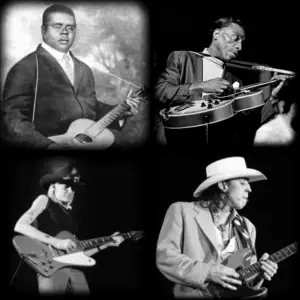TEXAS BLUES
 Texas has long been a fertile source of Blues music, and it continues to uphold that tradition, but there is a difference between the early days and the present. What we know today as ‘Texas Roadhouse Blues’ is typically a boogie-heavy dance music that sprang from a long tradition of live music in bars. Austin is known as ‘the live music centre of the world’, and the typical Texas ‘roadhouse’ is arguably the modern equivalent of the ‘juke-joint’, a place to drink, dance and forget your cares. But back at the beginning of the 20th Century, Texas Blues meant something different. The familiar 12-bar structure and AAB rhyme scheme from the Delta Blues provided a simple and effective means to construct a song, and hundreds of ‘footloose bards’ and ‘wandering songsters’ used it to compose their own material. The typical guitar style of a Texas musician was a combination of Delta slide-guitar and Piedmont fingerpicking, neither as dark and dramatic as the first, nor as delicate as the second. They incorporated the Blues style into their repertoire of Folk songs, Spirituals, ragtime tunes and vaudeville numbers, much as they did all over the South.
Texas has long been a fertile source of Blues music, and it continues to uphold that tradition, but there is a difference between the early days and the present. What we know today as ‘Texas Roadhouse Blues’ is typically a boogie-heavy dance music that sprang from a long tradition of live music in bars. Austin is known as ‘the live music centre of the world’, and the typical Texas ‘roadhouse’ is arguably the modern equivalent of the ‘juke-joint’, a place to drink, dance and forget your cares. But back at the beginning of the 20th Century, Texas Blues meant something different. The familiar 12-bar structure and AAB rhyme scheme from the Delta Blues provided a simple and effective means to construct a song, and hundreds of ‘footloose bards’ and ‘wandering songsters’ used it to compose their own material. The typical guitar style of a Texas musician was a combination of Delta slide-guitar and Piedmont fingerpicking, neither as dark and dramatic as the first, nor as delicate as the second. They incorporated the Blues style into their repertoire of Folk songs, Spirituals, ragtime tunes and vaudeville numbers, much as they did all over the South.
Early days- Music from everywhere!
Wandering songsters and ‘footloose bards’.
By the end of WW 1, pioneers of old-school Texas Blues like Blind Lemon Jefferson and Huddie ‘Lead Belly‘ Ledbetter were a familiar sight on street-corners and in bars. Typically, one of Lead Belly’s most famous songs, ‘Goodnight Irene’ was an Irish song played in waltz time, and was something he picked up in a bar on Fannin Street in Shreveport several years earlier. When record companies from the North sent out their field-recording units in the late 20s, there was a lot of Blues music embedded in the local Texas culture. Lemon Jefferson made his first recording in 1926, and the following year, Blind Willie Johnson recorded the first of his fearsome Gospel-themed Blues classics. Texas Alexander, a man with a voice that could shake a tree, was often accompanied by his young cousin Sam ‘Lightnin’ Hopkins on guitar as he declaimed his passionate and highly personal Blues.
The start of electric Blues.
Sam Hopkins had been a ‘lead-boy’ for Lemon Jefferson when he was in Houston, and would go on to great things, as did another kid who would lead Lemon around Dallas, Aaron ‘T-Bone’ Walker. Both these men had a huge effect on the Blues scene: T-Bone was hugely influential as he pioneered electric Blues guitar when he relocated to the West-coast before WWII, and when ‘Lightnin’ played his blistering electric ‘Sky Hop’ in 1954, it was a game-changer for many young guitarists. Both men played an important part in bringing Texas Blues into the new era when The Blues infiltrated popular music after ‘the British Invasion’ of the 60s.